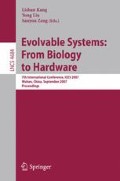Abstract
In this paper extended Hamming distance is introduced to construct the search space. According to the features of this space, a hierarchical mutation strategy is developed for the purpose of enlarging the search area with less computation effort. A local learning principle is proposed. This principle is used to ensure that no mutation operates on the same locus of chromosomes within one generation. An evaluation method called fitness effort for calculating computational effort per increased fitness value is also given. Experimental results show that the proposed hybrid approach of hierarchical mutation and local learning can achieve better performance than traditional methods.
Access this chapter
Tax calculation will be finalised at checkout
Purchases are for personal use only
Preview
Unable to display preview. Download preview PDF.
References
Shipman, R., Shackleton, M., Harvey, I.: The Use of Neutral Genotype-phenotype Mappings for Improved Evolutionary Search. BT Technology Journal 18, 103–111 (2000)
Sekanina, L.: Evolutionary Design of Gate-Level Polymorphic Digital Circuits. In: Rothlauf, F., Branke, J., Cagnoni, S., Corne, D.W., Drechsler, R., Jin, Y., Machado, P., Marchiori, E., Romero, J., Smith, G.D., Squillero, G. (eds.) EvoWorkshops 2005. LNCS, vol. 3449, pp. 185–194. Springer, Heidelberg (2005)
Miller, J.F., Job, D., Vassilev, V.K.: Principles in the Evolutionary Design of Digital Circuits – Part I. In: Banzhaf, W. (ed.) Genetic Programming and Evolvable Machines, vol. 1(1/2), pp. 7–35. Kluwer Academic Publishers, Netherlands (2000)
Levi, D.: HereBoy: A Fast Evolutionary Algorithm. In: Proceedings of the 2nd NASA/DoD Evolvable Hardware Workshop, IEEE Computer Society Press, Los Alamitos, CA (2000)
Liu, H., Miller, J.F., Tyrrell, A.M.: Intrinsic Evolvable Hardware Implementation of a Robust Biological Development Model for Digital System. In: Deb, K., et al. (eds.) GECCO 2004. LNCS, Springer, Heidelberg (2004)
Yu, T., Miller, J.F.: The Role of Neutral and Adaptive Mutation in an Evolutionary Search on the OneMax Problem. In: Cantú-Paz, E. (ed.) GECCO 2002. Late Breaking Papers at the Genetic and Evolutionary Computation Conference, New York, pp. 512–519 (2002)
Miller, J.F.: Cartesian Genetic Programming. In: Poli, R., Banzhaf, W., Langdon, W.B., Miller, J., Nordin, P., Fogarty, T.C. (eds.) EuroGP 2000. LNCS, vol. 1802, pp. 121–132. Springer, Heidelberg (2000)
Layzell, P.: Visualizing Evolutionary Pathways in Real-World Search Spaces. Technical report 308, Hewlett Packard (2002)
Sekanina, L.: Design Methods for Polymorphic Digital Circuits. In: Proc. of 8th IEEE Design and Diagnostic of Electronic Circuits and Systems Workshop, Sopron, HU, UWH, pp. 145–150. IEEE Computer Society Press, Los Alamitos (2005)
Sekanina, L., Vašíček, Z.: On the Practical Limits of the Evolutionary Digital Filter Design at the Gate Level. In: Rothlauf, F., Branke, J., Cagnoni, S., Costa, E., Cotta, C., Drechsler, R., Lutton, E., Machado, P., Moore, J.H., Romero, J., Smith, G.D., Squillero, G., Takagi, H. (eds.) EvoWorkshops 2006. LNCS, vol. 3907, pp. 344–355. Springer, Heidelberg (2006)
Walker, J.A., Miller, J.F.: Evolution and Acquisition of Modules in Cartesian Genetic Programming. In: Keijzer, M., O’Reilly, U.-M., Lucas, S.M., Costa, E., Soule, T. (eds.) EuroGP 2004. LNCS, vol. 3003, pp. 187–197. Springer, Heidelberg (2004)
Székely, G.: Learning is Remembering. In: Behavioral and Brain Sciences, vol. 20, pp. 577–578. Cambridge University Press, Cambridge (1997)
Author information
Authors and Affiliations
Editor information
Rights and permissions
Copyright information
© 2007 Springer-Verlag Berlin Heidelberg
About this paper
Cite this paper
Li, J., Huang, S. (2007). Evolving in Extended Hamming Distance Space: Hierarchical Mutation Strategy and Local Learning Principle for EHW. In: Kang, L., Liu, Y., Zeng, S. (eds) Evolvable Systems: From Biology to Hardware. ICES 2007. Lecture Notes in Computer Science, vol 4684. Springer, Berlin, Heidelberg. https://doi.org/10.1007/978-3-540-74626-3_35
Download citation
DOI: https://doi.org/10.1007/978-3-540-74626-3_35
Publisher Name: Springer, Berlin, Heidelberg
Print ISBN: 978-3-540-74625-6
Online ISBN: 978-3-540-74626-3
eBook Packages: Computer ScienceComputer Science (R0)

